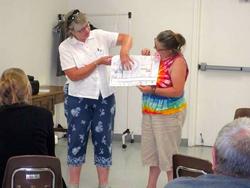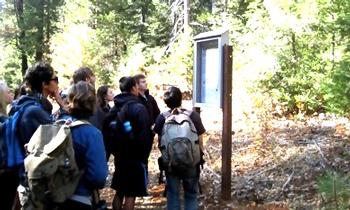2012-2013 Funded Projects


Enhancing In-the-Woods Education for Key Sierra Forest Stakeholders
Project Leader: Robert York UC Berkeley Blodgett Forest Research Station
To enhance outreach at an existing and popular forest education and demonstration site billboards that provide applied research results for the site visitors and form a trail of epiphany was developed and placed at the site. The billboards are wildly successful with site visitors and several have taken the time to let us know, including the leadership of USFS Region 5 and Cal-Fire and California Legislature members and staff. Groups come to ask for tours so often it has became impossible to accommodate all the requests.
Preservation, Protection and Management of California's Oaks
Project Leaders: Scott Oneto & Rebecca Miller-Cripps UC Cooperative Extension Central Sierra
This RREA project developed and presented fifteen in person, single-session workshops throughout the five-county Central Sierra area; private landowners and managers, landscape professionals, arborists, and Master Gardeners were provided with information and educated about the management of oak forests. Educational materials created for this project included brochures and one-page publications about general oak ecology, Central Sierra oak identification, and landscaping with oaks.
Annual Rangeland Management Handbook
Project Leader: Melvin George Emeritus: UC Davis Department of Plant Sciences
Given the gradual loss of institutional memory a handbook on the ecology and management of California's annual rangelands, grasslands, oak-woodlands, and chaparral is in development. In this first year RREA funding allowed us to confirm authorship of each chapter, locate published and unpublished research reports from research stations and counties in addition to UC ANR and USDA livestock and range publications that date back to 1895. Several chapter drafts for the handbook are completed.
Aquatic Invasive Pest Species Detection and Prevention Education for Public Works Personnel Working in Fresh Water Ecosystems
Project Leader: Leigh Johnson Emerita: UC Cooperative Extension San Diego County
The purpose of this project, partially funded by RREA, was to reduce risks to freshwater ecosystems posed by aquatic invasive species. We developed materials and trained staff of public agencies that work in California wetlands and watersheds; 213 people attended the trainings and now recognize and are reporting invasive pest species encountered.
California Naturalist Program Support for Southern California
Project Leader: Sabrina Drill UC Cooperative Extension Los Angeles County
RREA support allowed us to greatly expand and enhance the new statewide California Naturalist Program in Southern California. We developed a detailed inventory of potential partners, developed and presented a California Naturalist instructor-training workshop, substantially revised drafts of existing California Naturalist documents, developed a package of documents for partnering organizations, and developed drafts and outlines for 2 advanced education modules, South Coast Bioregion and Urban Ecology. A Standard Operating Procedures guide and forms to help institutionalize procedures for the California Naturalist Program were also developed.
Grazing Brush to Reduce Fire Impacts
Project Leader: Glenn Nader Emeritus: UC Cooperative Extension Sutter-Yuba Counties
RREA funds supported a summer intern student who located information and developed a draft publication, Targeted Grazing to Reduce Fire Fuel Loads in California Chaparral. When finalized, the publication will allow grazers and landowners to determine timing of the grazing event and how to supplement their animals during the seasons, allowing production while reducing fuels.
Clear Lake Information Public Online Database (Clear Lake Info--POD)
Project Leader: Lisa C. Thompson UC Davis Wildlife & Fisheries Biology
Clear Lake is California's largest natural lake and management of its water quality is particularly challenging; this RREA funding supported a student intern who located, reviewed, and summarized information found on Clear Lake’s water quality and ecology. The information is available on the website developed by the student; Clear Lake Aquatic Website.
